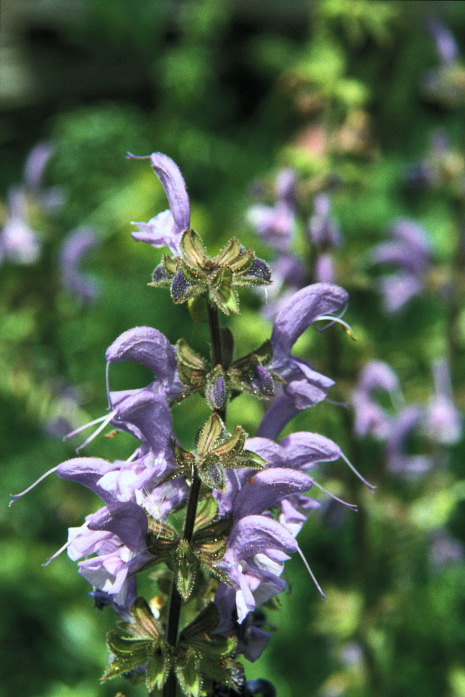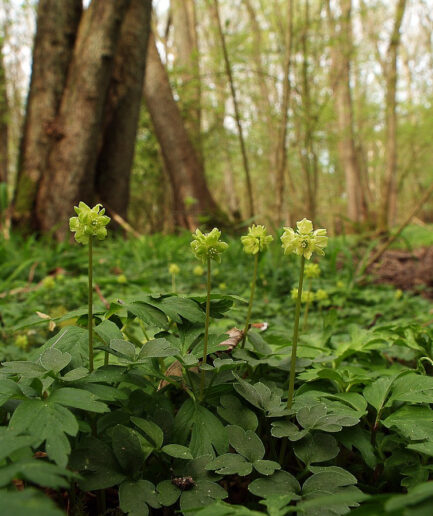Meadow Clary
Scientific Name: Salvia pratensis L.
Family: Lamiaceae
MORPHOLOGY
Growth habit and size: Perennial herbaceous plant, non-sticky, with a thickened taproot, reaching heights between 30 and 70 cm.
Stem: Erect, quadrangular stems, pubescent with reflexed hairs, woody and branched at the top.
Leaves: The leaves are thick and bulging, basal leaves are petiolate, arranged in a rosette, characterized by a reticulate venation, slightly crenate or lobed margins; the cauline leaves are smaller, sessile and often semi-clasping the stem. The upper side is wrinkled, the lower side is hairy.
Flowers: The flowers, borne on short pedicels, are blue-violet, rarely pink or whitish, arranged in 4-5 verticillasters situated in the axils of green bracts; together they form a closed spike. The calyx is bilabiate, hirsute, hairs are never white; the calyx tube is longer than the five calyx lobes. The corolla has a falcate upper lip: the bifid style protrudes; the lower lip is spreading or reflexed, with a denticulate margin. It blooms from April to August.
Fruits and seeds: The schizocarpic fruit is a microbasarium (tetranutlets) with four obovoid or ellipsoid brown mericarps (nutlets).
DISTRIBUTION AND HABITAT
It grows throughout Italy except in the major islands and in Puglia, Basilicata, and Calabria, from sea level to 1,600 m. It grows in lean pastures, meadows, rocky places, clearings, and is frequent in dry and sunny places.
USE
A medicinal plant known since ancient times. It is believed to have multiple virtues. Effective in cases of liver disorders, respiratory tract infections, and depressive and anxious states. Considered diuretic, antiseptic, and even aphrodisiac. Sage decoction is an excellent cardiac tonic. Dried leaves, pounded and mixed with honey, create a compound famous for its expectorant properties. Even white wine boiled with a handful of sage leaves would be recommended for diabetics as it helps lower blood sugar levels when taken after meals. Before taking any plant-based product (medicinal or non-medicinal) for therapeutic or similar purposes, it is always advisable to consult a doctor.
INTERESTING FACTS
The stamens behave like small levers: when an insect, in search of nectar, enters the flower, it activates a balance mechanism that flips the stamen arm carrying the anther onto the insect’s back, then spilling pollen onto the insect’s back. Sage has been known since ancient times, and it is said that even Cleopatra used it to prepare aphrodisiac potions. The Gauls considered it a panacea, capable of curing all ailments. The Druids used it against fever, cough, paralysis, epilepsy, but also to promote conception and childbirth. It was also believed to have the power to resurrect the dead and was used as an ingredient in many spells. Hippocrates recommended its use for wounds, while the Egyptians used it for embalming the dead. The Romans used it to preserve meat and believed it made them immortal; they called it “sacred herb” and attributed to it the ability to cure snakebites, provided it had not been infected by the venomous breath of toads, and for this reason, they believed that only a few lucky people, dressed in a particular way and after making certain sacrifices, could collect it. This belief is found in the “Decameron.” The doctors of the Salerno school wondered, “Why should a man die in whose garden sage grows?” In the following centuries, various properties were attributed to this plant: that of helping a woman become pregnant after drinking its infusion for 4 consecutive days, or that of curing oral affections, because the shape of the leaves resembled a tongue, or the power to break spells and enchantments.
Photos: Kindly provided by Claudio Farinati





















